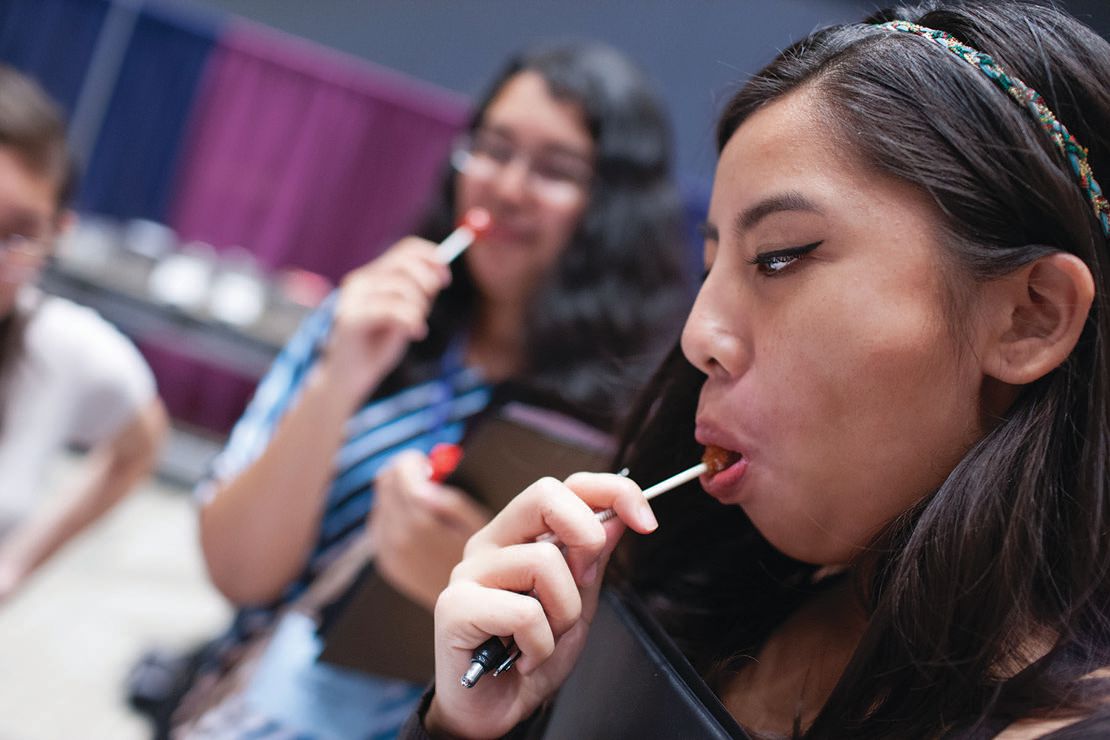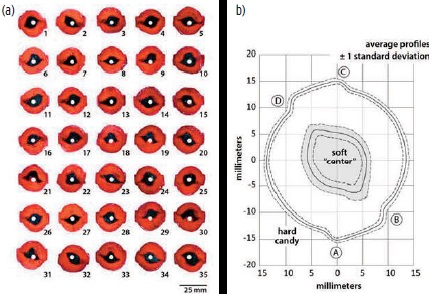How many licks?
Drs. Wilfred T. Tysoe & Nicholas D. Spencer | TLT Cutting Edge December 2014
Exploring the complex world of biotribocorrosion with basic tribological principles and an army of lollipop-lickers.
 www.canstockphoto.com
www.canstockphoto.com
READERS OF THIS COLUMN DO NOT NEED TO BE TOLD THAT TRIBOLOGY IS A COMPLEX, MULTIDISCIPLINARY TOPIC. Biotribology and tribocorrosion bring with them even greater levels of complexity, while biotribocorrosion may seem like a lost cause when it comes to quantitative understanding and prediction. Nevertheless, the topic of biotribocorrosion is of great importance in applications ranging from implants to marine engineering.
A refreshingly original, potentially important and thoroughly entertaining article on a well-defined biotribocorrosion problem was recently published in
Tribology Letters by a group from the University of Florida led by professor Greg Sawyer. The paper posed the question: “How many licks does it take to reach the center of a lollipop?”—specifically the soft core of a Tootsie-Pop. The researchers approached the problem armed with classical tribological methods, state-of-the-art optical metrology equipment, Monte Carlo statistical modeling techniques and high school students who participated as volunteer lickers in an experiment during STLE’s 2014 Annual Meeting STEM Camp last May.
One of the issues that has made quantitative studies of biotribocorrosion challenging has been the dual processes of corrosion and wear, which are, on the one hand, chemical and time-dependent and, on the other hand, mechanically driven and cycle dependent. To make things more challenging, these processes are coupled to each other in a complex way. In this study, the situation was simplified by lumping the corrosion and wear aspects together in a single, cyclic volumetric material removal parameter, supported by the statistical data from the 58 lickers. The experimental data were then fed into Monte Carlo simulations, varying the input parameters to a simple wear equation, based on the variability observed in the measured wear rates.
First, the lollipops had to be characterized by weighing and shape analysis. The latter involved cutting them equatorially in a band saw, polishing them and subjecting them to optical metrology (Figure 1(a)). In this way, an “average” Tootsie Pop could be defined (Figure 1(b)). Also, a number of control experiments had to be performed, such as determining the mass-loss when licking with a dry tongue (negligible removal rate) or dissolution in a water bath or in a mouth with no movement (around 7-9 mg/s, depending on degree of agitation). In contrast, typical mass-loss rates during licking were in excess of 17 mg/s, clearly indicating the synergy between wear and dissolution during the licking process.
 Figure 1. 35 equatorial cross-sections of randomly selected Tootsie Pops illustrating the variation in shape and size, especially of the soft Tootsie Roll centers (shown on the left). The composite average Tootsie Pop outline (shown on the right). Reproduced from [1] by kind permission of Springer.
Figure 1. 35 equatorial cross-sections of randomly selected Tootsie Pops illustrating the variation in shape and size, especially of the soft Tootsie Roll centers (shown on the left). The composite average Tootsie Pop outline (shown on the right). Reproduced from [1] by kind permission of Springer.
The sliding partner during licking, of course, was the tongue or palate, which typically has an R
a of around 33 μm, a modulus of about 15 kPa and exerts a normal force of around 3N (corresponding to a few kPa) during licking. Two clear modes of lollipop-licking were observed among the volunteers: single sided (tongue only, 17 mg per lick) and full surface (tongue and palate, 62 mg per lick). The licking experiments themselves involved weighing after every 10 licks, which had to be performed in a consistent manner. From these data, the volumetric removal per lick could be determined and hence a lumped-parameter wear rate.
Five thousand Monte Carlo simulations of the evolution of surface geometry were carried out, based on the range of input parameters determined from the experiments. Interestingly for the first 150 cycles, the average wear depth was found to vary little between the two licking styles, despite the large differences in volumetric wear rates. This is presumably due to the large difference in contact area between the two styles.
The pressure regime and chemical environment in this study is not so dissimilar from that of many other biological environments where biotribocorrosion is a concern. The statistical approach, coupled with the lumping of processes with intrinsically different evolutions over time, is highly relevant to the treatment of problems with greater biomedical significance than lollipops. Amusing as this study may be, it could serve as a valuable stimulus to further advances in biotribocorrosion.
By the way, the answer is 130 licks to the center.
FOR FURTHER READING:
1.
Kyle G. Rowe, Kathryn L. Harris, Kyle D. Schulze, Samantha L. Marshall, Angela A. Pitenis, Juan Manuel Urueña, Sean R. Niemi, Alexander I. Bennett, Alison C. Dunn, Thomas E. Angelini and W. Gregory Sawyer, “Lessons from the Lollipop: Biotribology, Tribocorrosion, and Irregular Surfaces,”
Tribology Letters, in press.
 Eddy Tysoe is a Distinguished Professor of Physical Chemistry at the University of Wisconsin-Milwaukee. You can reach him at wtt@uwm.edu
Eddy Tysoe is a Distinguished Professor of Physical Chemistry at the University of Wisconsin-Milwaukee. You can reach him at wtt@uwm.edu.
 Nic Spencer is professor of surface science and technology at the ETH Zurich, Switzerland. Both serve as editors-in-chief of STLE-affiliated Tribology Letters journal. You can reach him at nspencer@ethz.ch
Nic Spencer is professor of surface science and technology at the ETH Zurich, Switzerland. Both serve as editors-in-chief of STLE-affiliated Tribology Letters journal. You can reach him at nspencer@ethz.ch.